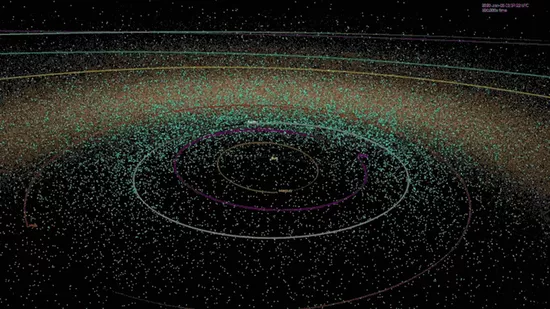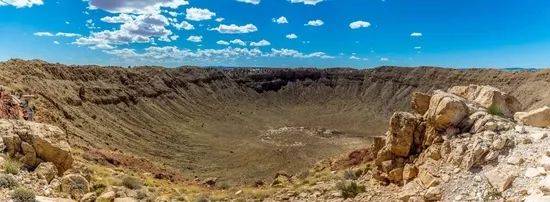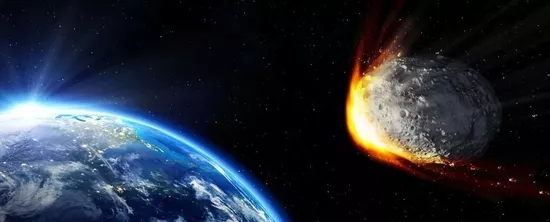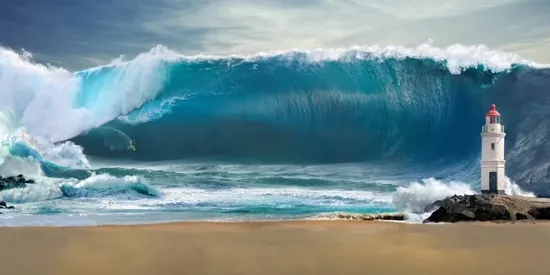Not long ago, a science fiction news hit the hot search. Wuyanhua, deputy director of the National Space Administration, said that China will start to build a near Earth Asteroid defense system... To truly respond to the threat of asteroids and extraterrestrial objects to the earth's home in the future, and truly make China's new contribution.

So, what is a near Earth Asteroid? What threat do they pose to the earth? How to remove their threat? Let's talk about this today!
01
Thanks to the asteroid "don't kill"
The so-called "near Earth Asteroid" is an asteroid whose orbit intersects with the earth's orbit, or which may intersect with the earth's orbit after being perturbed by the planet's gravity in the future. You know, there are no traffic lights, traffic police, or switchmen in the solar system. These asteroids intersect with the earth's orbit, and there is a risk of hitting the earth at one end. (for the sake of simplicity, when we talk about "asteroids" and "small objects", we also include the cometary nucleus of comets. After all, it is similar to "asteroids" in terms of damage to the earth.)

Known solar system small objects as of january2018
Small objects in the main asteroid belt are marked in brown, and small near earth objects are marked in cyan
The earth's orbit is grayish white, that is, the third circle from inside to outside
Figure source NASA
Some friends may think that the universe is so big and asteroids are so small, so the possibility of hitting the earth must be very small, right?
But the opposite is true.
For example, everyone has taken a car, and must have experienced the scene of rain crackling on the windows in a heavy rain day. If the earth is a car, the windows of the earth will crackle all the time in the driveway around the sun, but the things that hit are not rain.

It is estimated that 25million meteoroids, large and small, enter the earth's atmosphere every day, accumulating about 15000 tons a year.
The reason why you can still read this article with your mobile phone is that fortunately most meteoroids are very small. Most of the meteors that can be seen are caused by small bodies the size of sand or mung beans. Their sparrow tactics usually do not cause serious consequences.
However, "meteoroid" and "asteroid" are just human classification terms, and there is no clear boundary between them. If a "meteoroid" grows big enough, it may always hit the lower atmosphere or even the ground, causing major disasters. Here are some famous ones:
On the morning of february15,2013, a fire meteor crossed the sky over Chelyabinsk, Russia, and its light overwhelmed the rising sun. The Fire Meteor also left a dust track about 10 kilometers long in the air. The meteorite that was not burned in the air smashed a 6-meter-wide hole in the frozen chebakur lake. More than 7200 houses were damaged by the explosion wave of fire meteors, and 1491 people were indirectly injured. It is estimated that the fireball event in Chelyabinsk was caused by an asteroid with a diameter of 17 to 20 meters.
Historically, more massive celestial impacts have not been far away.
On June 30, 1908, in Russia, an earth shaking explosion occurred over the Tunguska river. The shock wave shattered the window glass within a radius of 650 kilometers, and more than 80million trees with an area of 2150 square kilometers were burned down. The barograph in Britain detected the pressure fluctuation caused by the explosion. Now the scientific community generally believes that the perpetrator of the Tunguska big bang was a rocky asteroid with a diameter of about 65 meters.

The most famous asteroid impact site is probably the Chicxulub crater in Mexico. About 66million years ago, an asteroid with a diameter of at least 10 kilometers hit here at a speed of 20 kilometers per second, opening the prelude to the Cretaceous extinction event. 75% of the species on the earth, including all non bird dinosaurs, bid farewell to the earth's life stage forever in this extinction event.
So from this point of view, human beings may really have to thank asteroids for their "grace of not killing" to develop to the present.
02
How powerful is the impact
I'm afraid you can't write down one line
As mentioned above, a 10 kilometer asteroid caused a mass extinction. You may wonder: can a 10 kilometer stone, that is, the size of a city, harm the world with a surface area of 500million square kilometers?

Don't forget that this stone is still 10 kilometers high - more than 1000 meters higher than Mount Everest. When such a huge mountain hits the ground at a high speed, we can calculate the energy it carries by using the kinetic energy formula (the process of combining the formula is omitted):
This energy ≈ density × diameter ³× speed ² ÷ 3.82
Fill the data into the formula one by one, all in accordance with the standard units of the international system of units. The average density of carbonaceous chondrites is 3300 kg / m3, the diameter is 10000 meters, and the speed is 20000 meters / second. As you can see, this formula calculates the product of various thousands of square and cubic meters. The final result is about 3460000000000000000 joules - the top three estimates of the impact by the scientific community are 420, but the magnitude is the same. It is a 24 digit number (you see, there is really no ↓↓↓↓ in the line).
420000000000000000000000 joules
What is this concept? It is equivalent to all the energy produced by the sun's core every millisecond, or the energy released by the explosion of 2million czar hydrogen bombs. If the surface of 500million square kilometers of the earth is evenly covered with water 2 meters deep and 0 ℃ then this energy is enough to boil all the water.
Fortunately, the impact energy at that moment will be concentrated at the impact point, which will completely vaporize the asteroid and burst a huge crater 100 kilometers wide and 30 kilometers deep on the spot, instead of spreading all the energy to the whole earth at once. But don't be happy too soon. The law of conservation of energy determines that it's only a matter of time before we receive the boxed lunch, because the impact caused by the impact is late but arrives
Starting from the impact point, there is a strong wind with a speed of 1000 kilometers per hour and a tsunami with a wave height of 1500 meters. In addition, 25 trillion tons of material will be thrown into the air in an instant, some of which will sputter into space and never return, and the other part will fall back to the earth. When they re-enter the atmosphere, they will ignite again, and the fire storm will sweep the world.

However, a large amount of dust generated by the impact and ash caused by combustion are suspended in the atmosphere, which blocks the sunlight for a long time and hinders the photosynthesis of plants. The ecosystem will collapse, and consumers at all levels in the upper food chain will perish one after another.
Come on, the earth has been abused like this. Will it be peaceful in the future? The attitude of asteroids is naturally:
I'm wrong. I'll dare again next time.
03
Human beings must not rely solely on asteroids to "not kill"
Although no asteroid has really dealt a fatal blow to mankind, we really can't gamble on this.
According to NASA estimates, about every 5000 years, an asteroid with a size of more than 140 meters will collide with the earth. On july25,2019, an asteroid with the temporary number 2019 OK flew by from 72000 kilometers away from the earth, which is less than one fifth of the distance between the earth and the moon. Is it scary enough to be so close? What is more terrifying is that it was not discovered by humans until the day before the flight!
On April 13, 2029, the asteroid 99942 with a size of 170~450 meters, also known as the "destroyer star", will fly over 32000 kilometers from the earth's surface, which is lower than the orbit of the synchronous satellite!
Humans boast of being intelligent creatures, but if they die like dinosaurs who don't read when they are hit by asteroids, it's very frustrating to think about it.
If you want to avoid being confused by asteroids, you must first know how many they are and where they are hiding. The sooner you find them, the better. Since nearly 30 years ago, a number of monitoring projects for small near earth objects have been launched one after another. On average, 40 Neos can be found every week, which has yielded a lot.

Figure source NASA
Why did deputy director Wu say that a ground-based and space-based monitoring system should be established? Is it not enough to observe from the ground? Not enough. Some asteroids came under the cover of bright celestial bodies. For example, the one in Chelyabinsk flew from the direction of the sun. If you want to find it in advance, you have to look at the stars during the day. Therefore, no one knows its arrival in advance.
Another example is 2019 OK (the asteroid number mentioned above), which is not OK. On the days when we should have seen it, we encountered a full moon. If the monitoring system is launched outside the atmosphere, the dark space will be next to the bright disc of the sun and moon, and "looking for stars during the day" can also be achieved.
So, if we are very lucky - or very bad - to find an asteroid that will hit the earth, how can we solve it?
04
Survival or destruction?
Never walk into that good night gently!
Hollywood sci-fi disaster blockbusters love to use asteroids to hit the earth. For example, the collision between heaven and earth and the Apocalypse all have the plot that humans try to blow up asteroids. The same is true in reality. In the face of the crisis of destruction, mankind will never wait to die. The good news is that there are many feasible schemes.
Once an asteroid is found threatening the earth, all possible solutions can be divided into two categories in the final analysis: disintegration and pushing away.
Disintegration means that asteroids are divided into scattered individuals (mainly by bombing). Fragments of small celestial bodies flying in multiple directions will miss the target and miss the earth, or they are small enough to burn up in the atmosphere.
Pushing away is to deflect the whole asteroid from its orbit, or make it accelerate or decelerate, and reach the appointment point ahead of time or behind time, so as to achieve the same miss effect. The equatorial diameter of the earth is 12756 kilometers, and the revolution speed is 30 kilometers per second. It takes 425 seconds, or about seven and a half minutes, to complete each length. The thrust of pushing away is to buy 425 seconds for the earth.
In terms of specific implementation measures, there are the following:
The easiest thing to think of is thermonuclear weapons. The large amount of heat energy generated by thermonuclear weapons can vaporize the asteroid locally, and use the temporarily generated gas to disintegrate the asteroid, or eject material to push the main body out of orbit. But we should also be careful. Once the plan fails, not only an asteroid will hit the earth, but also an asteroid with its own nuclear pollution.
The cold weapon method can launch an impactor to impact an asteroid and change its speed or direction. Or, in a non-contact way, let a tractor accompany the asteroid to take off, and gravity will gradually pull the asteroid off its orbit. The so-called "difference is a thousand miles away". If the plan is implemented early enough, there is hope that the asteroid will miss the target.
There are also many small ideas, such as sending an excavation projectile to the asteroid surface, constantly throwing the material on the asteroid surface into space, making it slowly disintegrate, and letting the law of conservation of momentum help change the asteroid orbit. Or use a laser or a focusing lens to vaporize the local surface of the asteroid, so that it is gradually pushed away by the ejected rock gas. And so on.
In terms of effective time, it can also be divided into two categories: Blitzkrieg and protracted warfare. Thermonuclear weapons or impactors are Blitzkrieg, while gravitational traction, excavation and ejection, and local ejection are protracted warfare. However, no matter which method is adopted, it needs to be discovered and arranged as soon as possible. At present, NASA's most optimistic estimate is that it will have a preparation period of 5 to 10 years, and is carrying out an impact experiment on the 65803 Didymos asteroid. The impact is expected to be completed by the end of September / early October 2022.
The implementation of a technical experiment in 2025 or 2026 proposed by deputy director Wu has been very aggressive in terms of schedule. From Wu's words, we can tell that the implementation plan is impact, but I don't know which asteroid we chose?
Finally, I would like to add something you like to see. Although people often think about the "natural disaster" when talking about the impact of a small celestial body on the earth, occasionally someone will become a local tyrant (of course, don't be on the scene when the impact occurs...).
For example, in Germany, there is a small town named nordlingen, with a population of less than 20000, located in a huge pit with a diameter of 25 kilometers and a depth of about 100 to 150 meters. At first, scientists thought the crater was a crater. Later, coesite, which can only be formed under high-speed impact, was found here, indicating that it was an impact crater formed by an asteroid with a diameter of 1500 meters 15million years ago.
The impact and high temperature have formed an estimated total of 72000 tons of impact diamonds. Unfortunately, these diamonds are very fine, no more than 0.2 mm at most, mixed in the soil, and inadvertently used by the city's builders to build roads and walls to build houses. Therefore, in terms of "diamond content", this small town is really rich in the soil, which is extremely rich.
Author Qu Jiong's works of popular science writers have been published in the National Museum, the National Space Administration, etc
Reviewed by | Liu Qian, researcher of Beijing Planetarium, director of popular science films and writer of popular science
This article is produced by the "scientific rumor refutation platform" (id:scienceu facts)